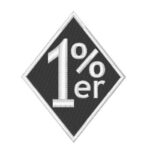Dynamo Bikes are experiencing a surge in popularity, especially within the growing communities of bikepacking enthusiasts and ultra-endurance cyclists. This increased interest is largely due to the practical ability of dynamo systems to continuously power bicycle lights and even charge electronic devices while on the move. For riders venturing on long journeys or simply seeking reliable, maintenance-free lighting for their daily commutes, dynamo bikes offer a compelling solution.
At the heart of a dynamo bike lies a clever piece of engineering – the dynamo itself. Typically integrated within the hub of the bicycle wheel, a dynamo is a generator that converts the kinetic energy produced by the wheel’s rotation into electrical energy. This generated power is then harnessed to operate dynamo-powered front and rear lights, ensuring consistent illumination without the reliance on batteries or the need for frequent charging.
This guide will delve into the world of dynamo bikes, covering essential aspects such as:
Understanding Bottle and Hub Dynamos: How Do They Work?
The core technology behind a dynamo bike’s power generation is electromagnetic induction. A dynamo hub operates on this principle by rotating powerful permanent magnets, usually embedded in the hub shell (known as the rotor), past a stationary coil of wire (the stator).
This process, electromagnetic induction, is essentially the reverse of how an electric motor functions. In most dynamo hubs designed for bicycles, the system is engineered to produce an output of six volts at a typical maximum power of three watts. Crucially, the electrical power output of a dynamo is directly proportional to the speed of the bicycle wheel – as you cycle faster, more power is generated.
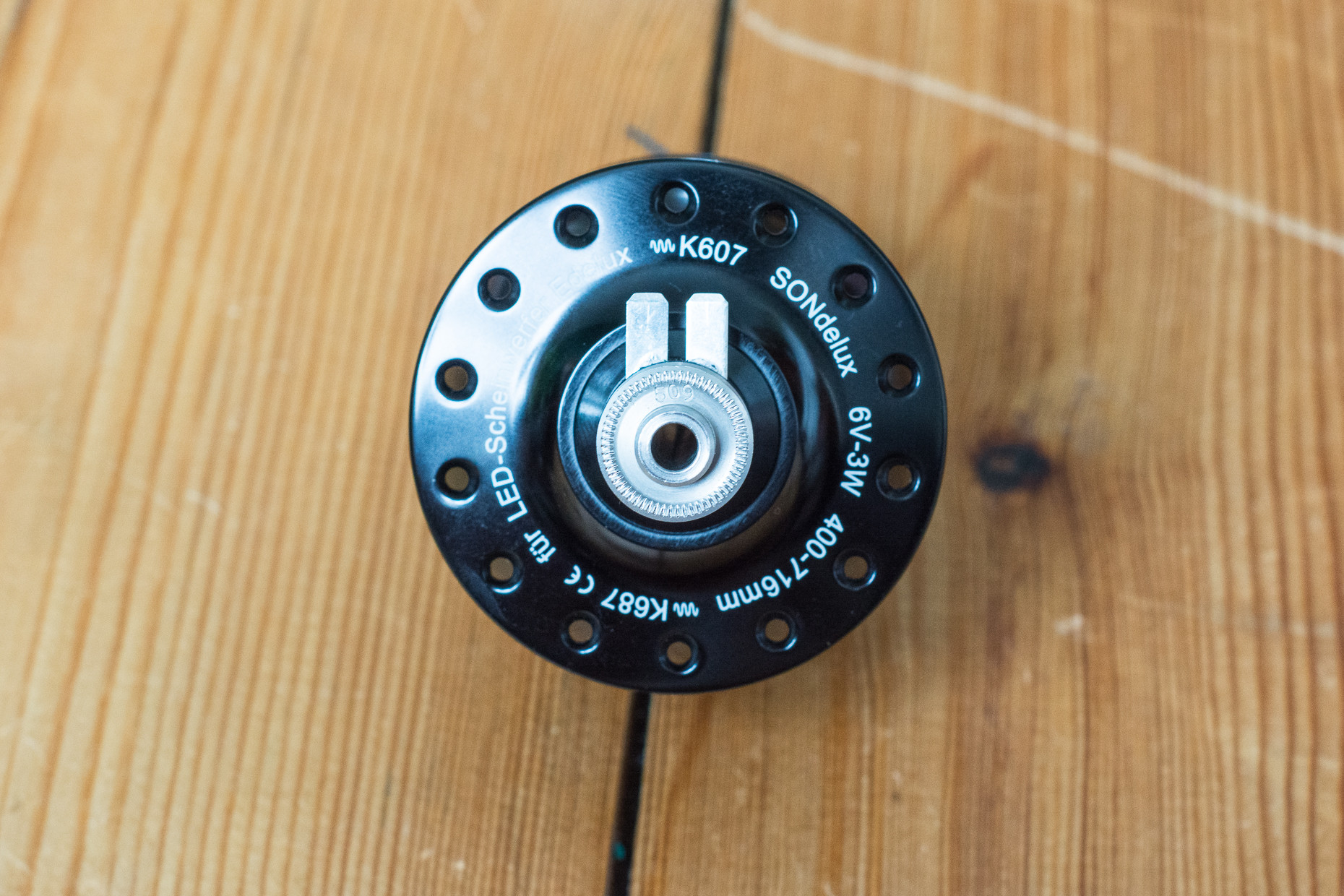 SON SONDelux dynamo hub
SON SONDelux dynamo hub
The electrical connections on a dynamo hub are typically designed as two prongs located on the driveside of the hub. These prongs serve as the interface for connecting the dynamo to your bicycle lights. While this two-prong system is the most common, some advanced systems are emerging that integrate the electrical connection directly into the bicycle’s fork, creating a cleaner, connectorless setup.
Dynamo hubs are predominantly installed in the front wheel hub of a bicycle. However, there are specialized designs that integrate the dynamo into the rear hub, although these are less common. The versatility of dynamo hubs is evident in their availability across a wide range of bicycle types. Whether your bike has rim brakes or disc brakes, or utilizes thru-axles or quick-release skewers, you can find a compatible dynamo hub.
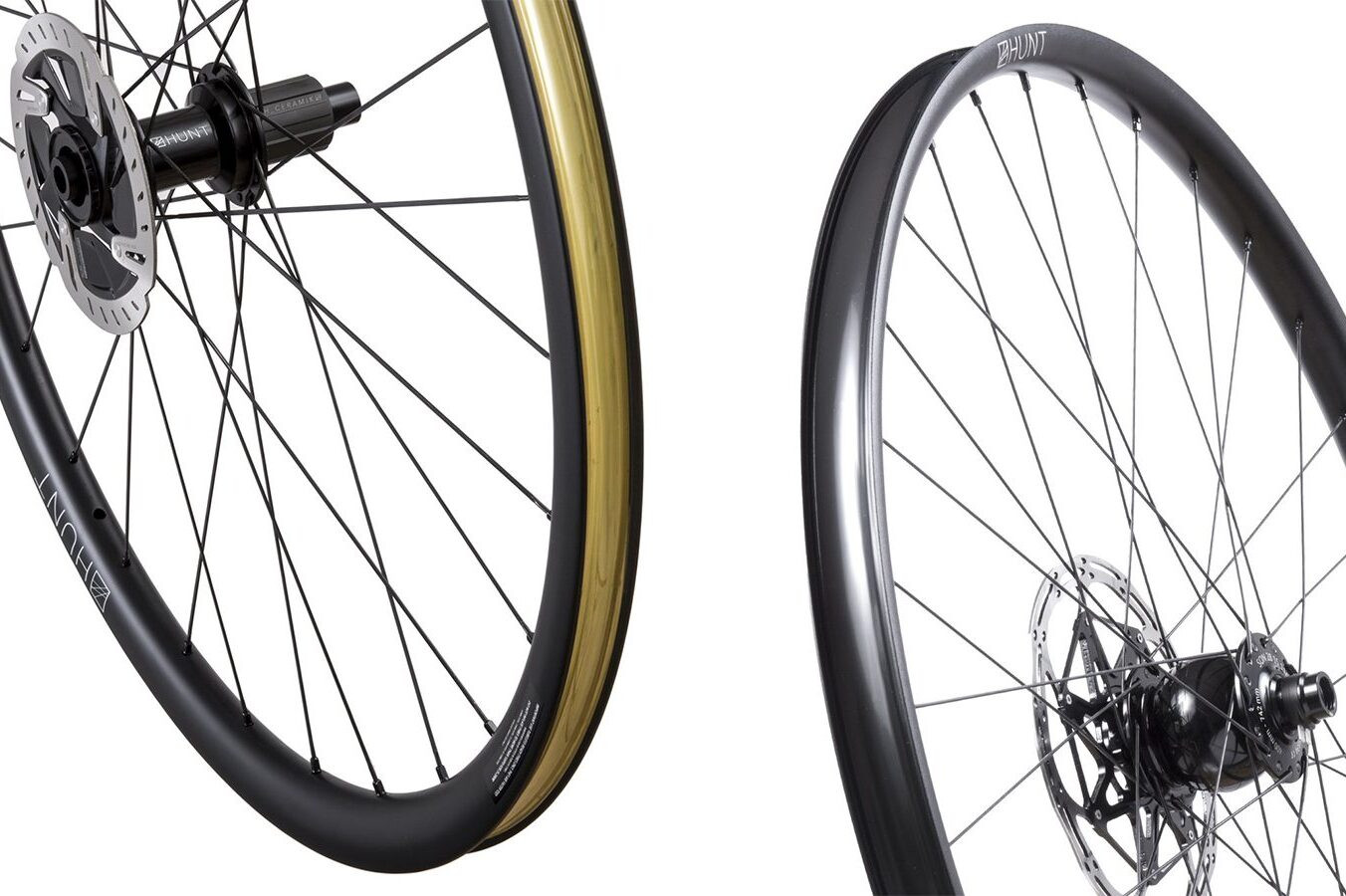 Hunt MTB dynamo wheels
Hunt MTB dynamo wheels
Furthermore, dynamo hubs are designed to accommodate various bicycle wheel sizes. This is a critical consideration because smaller diameter wheels rotate at a higher angular velocity compared to larger wheels when traveling at the same linear speed. Therefore, a dynamo hub optimized for a 700c wheel might produce excessive voltage if used with a smaller 20-inch wheel on a folding bike at high speeds, potentially damaging connected lights.
While many cyclists opt to build their own wheels around a chosen dynamo hub, several manufacturers, including Hunt, Halo, and Prime, offer complete dynamo wheelsets, simplifying the upgrade process.
Exploring Bottle Dynamos: A Sidewall Alternative
 I
I
Bottle dynamos, also known as sidewall dynamos, present an alternative approach to generating power for bicycle lights. Similar in principle to hub dynamos, bottle dynamos utilize a generator to convert mechanical energy into electrical energy. However, instead of being housed within the wheel hub, a bottle dynamo is mounted externally, typically bolted to the seatstays of the bicycle frame. This type of dynamo features a small wheel that makes direct contact with the outer edge of the bicycle tire or rim. As the wheel rotates, it spins the dynamo’s small wheel, generating electricity.
Bottle dynamos offer certain advantages. They are generally easier to install on existing bikes as a retrofit option compared to hub dynamos, which often require wheel rebuilding. Bottle dynamos are also typically more budget-friendly than hub dynamo systems. Another benefit is their ability to be disengaged completely when not needed, reducing drag.
However, bottle dynamos also have drawbacks. Their performance can be compromised in wet or muddy conditions due to slippage between the dynamo wheel and the tire. They also tend to be noisier in operation compared to the smooth and silent operation of most hub dynamos.
Dynamo vs. Alternator: Clarifying the Terminology
 Close up of a headlamp and a dynamo. Too, a concept for ecology, rural life and life outdoors.
Close up of a headlamp and a dynamo. Too, a concept for ecology, rural life and life outdoors.
For those with a penchant for technical accuracy, it’s important to note that most bicycle dynamos, whether hub or bottle types, are technically single-phase alternators, or more precisely, magnetos. These devices produce alternating current (AC). In the strictest technical sense, a true “dynamo” is defined as a generator that produces direct current (DC). Therefore, from a purely technical standpoint, referring to a dynamo hub as a “generator hub” would be more accurate.
So, how did the term “dynamo hub” become so prevalent and stick in cycling terminology? The answer lies in a phenomenon known as genericization, where a brand name becomes synonymous with a general product category, much like Xerox for photocopiers or Velcro for hook-and-loop fasteners. Sturmey-Archer, a renowned cycling component manufacturer, played a pivotal role in this. Their “Dynohub,” launched in the 1930s, was a widely successful generator hub. The popularity and widespread adoption of the Sturmey-Archer Dynohub led to “dynamo” becoming the common term in the cycling world for these generator hubs, even if technically, “alternator” or “generator” would be more precise.
Dynamo Lights: Reliable Illumination for Your Ride
While the term “dynamo” technically refers to the power-generating component, it’s often used, albeit somewhat inaccurately, to describe bicycle lights that are powered by a dynamo system. Therefore, “dynamo lights” generally refer to lights designed to be used with either hub or bottle dynamos.
Dynamo Headlights: Always-On Front Lighting
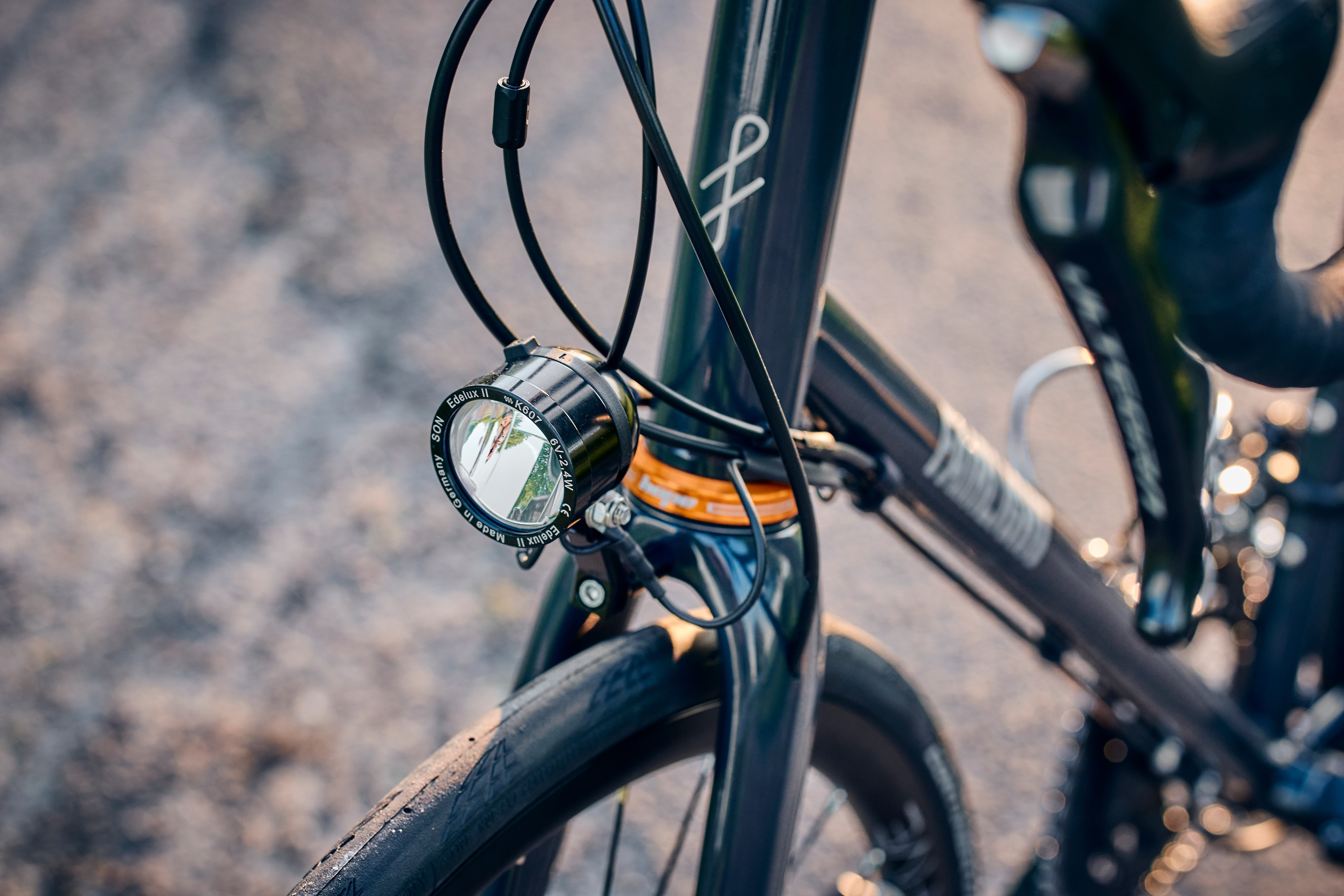 SON Edelux II dynamo headlight on Fairlight Strael
SON Edelux II dynamo headlight on Fairlight Strael
A dynamo bike headlight is specifically engineered to operate using the electrical power generated by a dynamo. Most dynamo headlights incorporate a small capacitor or battery, known as a “standlight,” which provides a short period of illumination even after the bicycle stops moving. However, the primary power source for a dynamo headlight is the spinning wheel. It’s important to note that almost all dynamo lights are designed exclusively for dynamo power and cannot be powered by standard batteries. There are a few exceptions, specialized bikepacking lights like the Llum Dynamo Light, which offer the flexibility to be powered by an external battery, but these are not the norm. Conversely, most battery-powered headlights cannot be directly powered by a dynamo, although some models, such as the Light & Motion Rando 500, offer a limited dynamo charging capability for their internal battery while riding.
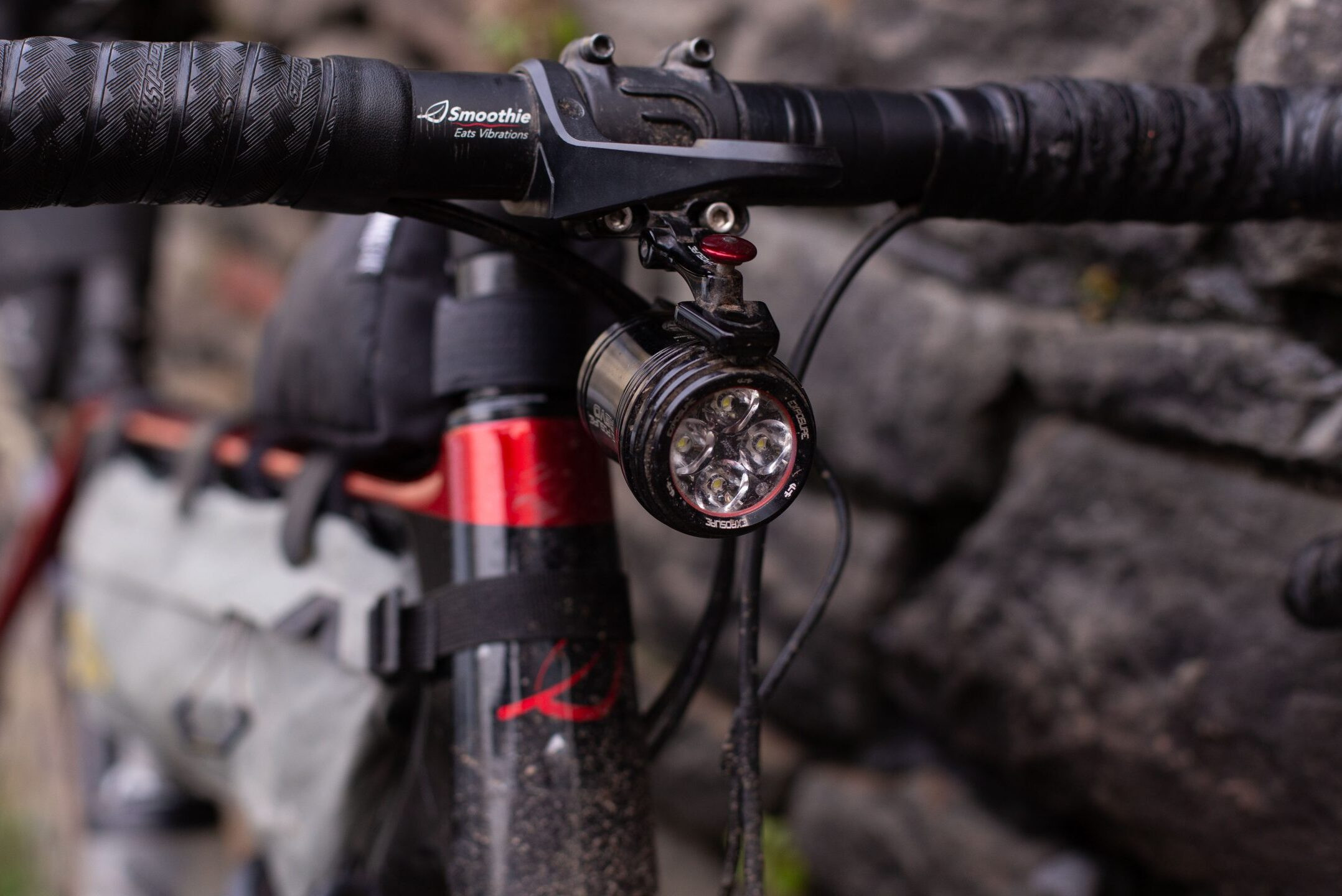 The Exposure Revo and Hunt Superdura Disc Dynamo wheel are my favourite parts on the bike.
The Exposure Revo and Hunt Superdura Disc Dynamo wheel are my favourite parts on the bike.
Modern LED-based dynamo headlights are surprisingly sophisticated. They incorporate internal circuitry to perform several key functions. First, they must convert the AC power produced by the dynamo into DC power, which is required for LEDs and electronic components. This conversion is achieved using a rectifier circuit. Dynamo headlights also typically include over-voltage protection circuitry to safeguard against potential damage from excessive voltage at high speeds. A logic circuit is also integrated to manage the standlight function, activating it when the bike slows down or stops.
Older incandescent dynamo lights were simpler in design, as they could operate directly on either AC or DC current, eliminating the need for rectification. However, these older lights are significantly less bright and reliable compared to modern LED dynamo lights and are now primarily found only on the most basic, budget-oriented dynamo lighting systems.
A significant distinction between dynamo headlights and most battery-powered bike lights is StVZO compliance. StVZO is a German standard that sets specific design requirements for bicycle lights to ensure road safety. A key feature of StVZO-compliant lights is a precisely shaped cut-off beam.
 100 LUX LUMOTEC IQ-X Beam – StVZO compliant beam example
100 LUX LUMOTEC IQ-X Beam – StVZO compliant beam example
This cut-off beam directs light effectively onto the road surface and path ahead, minimizing glare for oncoming drivers and pedestrians. Many cyclists, particularly road cyclists, appreciate the beam shape of StVZO-compliant lights for their ability to provide focused illumination without dazzling other road users. However, StVZO beam patterns are generally less ideal for off-road riding, where a wider beam pattern is often more beneficial.
Dynamo lights are particularly popular in Europe, and many leading manufacturers, such as SON, Busch + Müller (B&M), and Supernova, are based in Germany, where StVZO standards are prevalent.
 The Exposure Revo light is one of the nicest dynamo lights on the market
The Exposure Revo light is one of the nicest dynamo lights on the market
However, exceptions to the StVZO beam pattern exist. Lights like the KLite BikePacker Ultra V2, Exposure Revo, and Sinewave Beacon utilize a standard round beam pattern, which is often preferred for off-road cycling and bikepacking applications where a wider field of illumination is more advantageous.
Dynamo Rear Lights: Enhancing Visibility from Behind
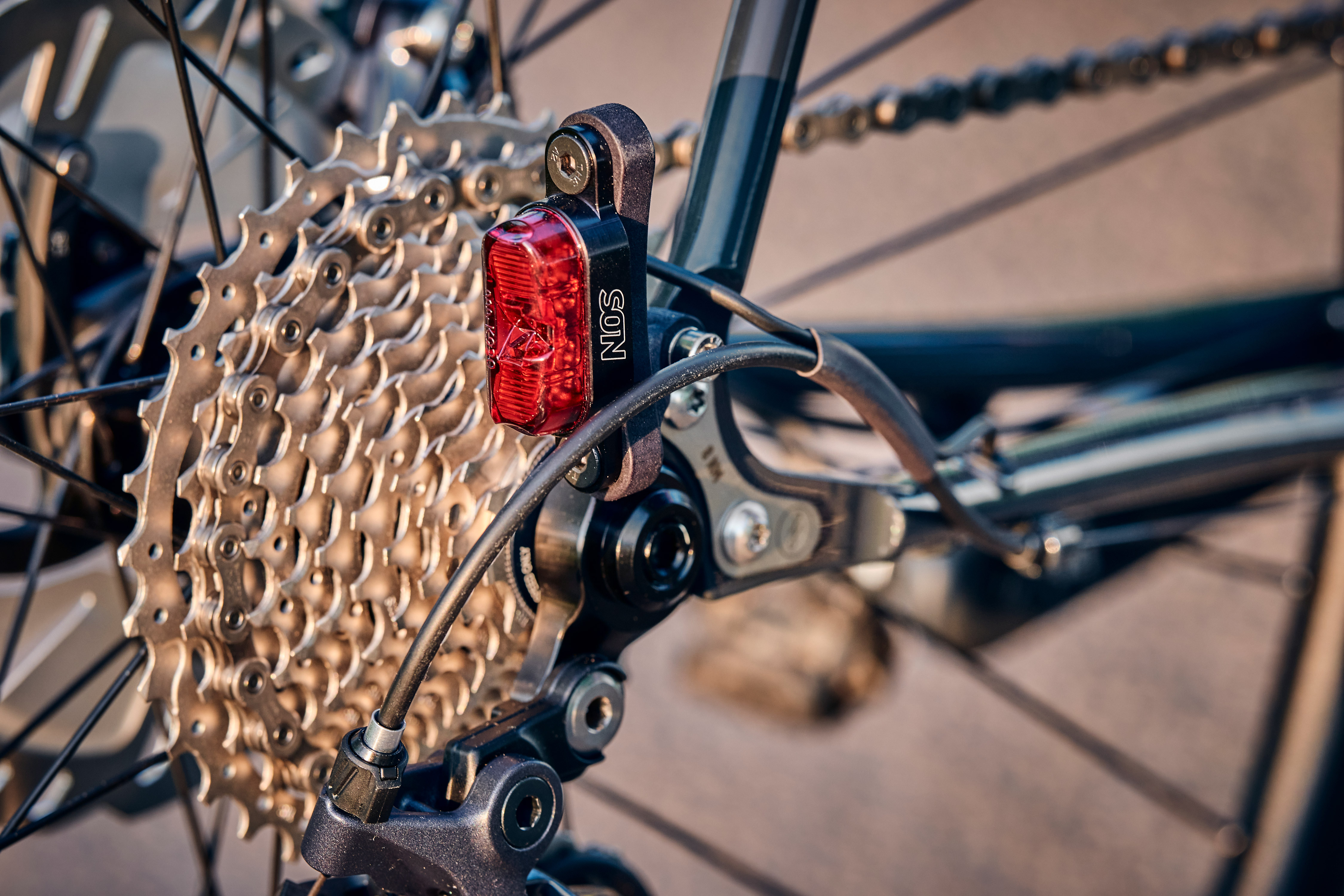 Rear dynamo light on Fairlight Strael
Rear dynamo light on Fairlight Strael
Dynamo rear lights for bicycles are typically connected via cables that run along the bike frame, often plugging into the back of the dynamo headlight. These basic rear lights are often simple in design, consisting of an LED within a protective casing with a long connecting cable. They rely on the standlight circuit within the headlight to maintain illumination when the bike is stationary.
 Rear dynamo light cable routing
Rear dynamo light cable routing
Dynamo lighting systems are generally designed for permanent wiring onto the bicycle, enhancing reliability and reducing the risk of theft or accidental detachment.
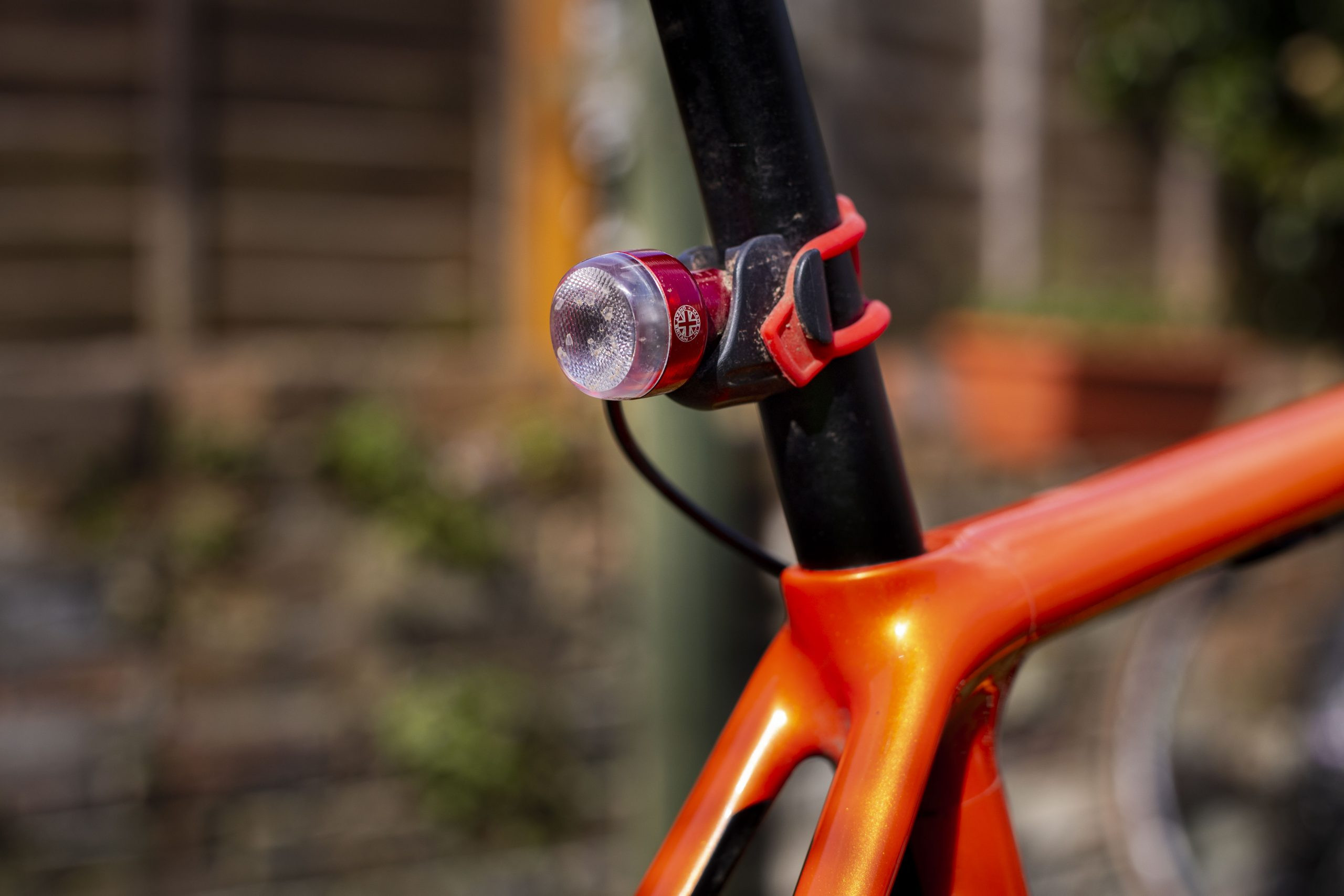 Cannondale Synapse Carbon Disc Ultegra endurance road bike
Cannondale Synapse Carbon Disc Ultegra endurance road bike
Most modern dynamo rear lights utilize a coaxial or twin-core cable for connection to the headlight. However, older systems sometimes used the bicycle frame itself as the ground connection for the electrical circuit.
Dynamo Drag and Noise: Understanding the Impact on Performance
Any dynamo system will introduce some degree of drag to a bicycle, but for most cyclists riding at typical speeds, this drag is likely to be negligible and imperceptible in everyday riding.
Independent lab testing conducted by Fahrrad Zukunft in 2014 quantified the drag introduced by dynamo systems. Their results indicated that even the least efficient dynamo hubs added only approximately 3 watts of drag at a normal riding speed of 20km/h (12.4 mph) when the light was switched off.
When the dynamo light is switched on, the drag increases, as expected. At the same speed of 20km/h with the light on, losses were measured to be around 6 watts for less efficient dynamos. At a higher speed of 30km/h (18.6 mph), the drag increased to approximately 8 watts for the least efficient dynamos tested.
The increase in drag when the light is activated is due to the physics of electricity generation. The electricity produced by the dynamo, which powers the lights, creates its own magnetic field. This magnetic field interacts with the magnets in the rotor, creating resistance and increasing drag as the current passes through the stator. The amount of drag is also related to the power draw. Using a lower-power headlight, such as a 1.5-watt model instead of a 3-watt headlight, will result in less drag, but also less light output.
In contrast, the most efficient dynamo hub tested, the SONDelux, added only about 6.5 watts of drag at 30km/h with the light switched on. To put this drag into perspective, cycling experts have noted that this difference is roughly equivalent to the drag caused by riding with a dirty bicycle chain compared to a clean and lubricated chain.
A Hunt 4-Season Aero rim laced to a SON Deluxe dynamo hub, illustrating a high-quality dynamo wheel build that minimizes drag and maximizes efficiency for road cycling.
Beyond drag, some cyclists may perceive a slight rumble or vibration transmitted through the handlebars, depending on the specific dynamo hub model and how the wheel is spoked. Radially laced dynamo wheels, in particular, have been noted to sometimes transmit more noticeable vibrations compared to cross-laced wheels. This is because the spoke crossings in a cross-laced wheel pattern can help dampen vibrations generated by the dynamo hub. Similarly, bottle dynamos, especially lower-quality models, can sometimes produce a noticeable buzzing sensation that is transmitted through the bicycle frame.
However, high-quality dynamo hubs, such as the SONDelux, are known for their exceptionally smooth and quiet operation. The rumble or buzz, if present at all, is often very subtle and easily tuned out during normal riding. The perception of dynamo noise and vibration is subjective and varies between individuals.
Legal Considerations for Dynamo Bike Lights
 Everything you ever wanted to know about bike dynamos
Everything you ever wanted to know about bike dynamos
In most jurisdictions, using dynamo lights on bicycles is perfectly legal. However, it’s always advisable to verify the specific lighting regulations in your country or region to ensure compliance. For example, in Germany, bicycle lights must meet the StVZO standards to be legally compliant. In the UK, while dynamos are permitted, there are specific regulations for bike lights that must be adhered to. Generally, as long as your dynamo lighting system includes both a front and rear light and incorporates a standlight feature to maintain illumination when stopped, it should meet legal requirements in most areas.
Charging Devices with Dynamo Power: On-the-Go Energy
 ‘The Plug’ stem provides USB charging via a dynamo front hub
‘The Plug’ stem provides USB charging via a dynamo front hub
Dynamo systems offer the added capability of charging electronic devices such as smartphones, GPS units, and bike computers while cycling. To achieve this, a rectifier is necessary to convert the AC current from the dynamo into DC current, which is compatible with most electronic devices. Some dynamo headlights, such as the Sinewave Beacon, Busch + Müller Lumotec IQ2 Luxos, and AXA Luxx70 Plus, come with integrated USB output ports for device charging. However, these integrated charging headlights are less common.
Most cyclists who intend to charge devices on the go opt for dedicated dynamo converters, also technically rectifiers. Popular options include the Sinewave Revolution, Cinq Plug5, and Kemo M172N. For those with DIY skills, it’s also feasible to construct a custom DIY USB dynamo charger.
It’s important to understand that dynamo-based charging for modern smartphones is typically best suited for trickle charging. The maximum power output from a dynamo system for charging is generally around 4 watts. In comparison, a standard “slow” iPhone charger delivers 5 watts, while fast chargers can reach 18 watts or higher. However, a dynamo charger is usually sufficient to power a GPS bike computer continuously during a ride.
Pros and Cons of Dynamo Bike Lighting Systems
Advantages of Dynamo Lights
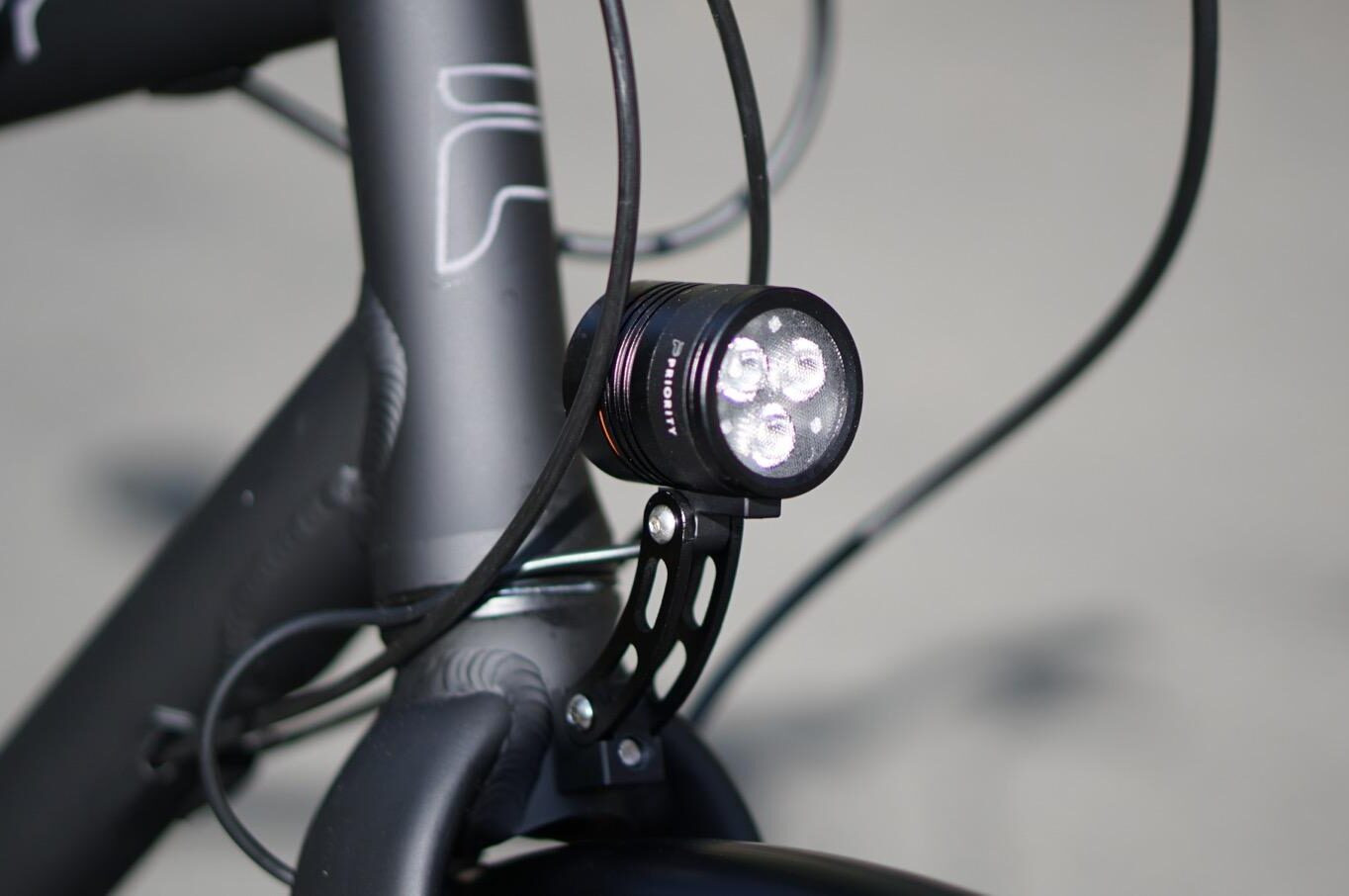 Everything you ever wanted to know about bike dynamos
Everything you ever wanted to know about bike dynamos
The suitability of a dynamo lighting system depends on individual cycling needs and preferences. However, dynamo lights offer compelling advantages for many cyclists, especially those who frequently cycle at night or undertake longer rides.
For regular bike commuters, dynamo lights are a highly practical choice. The convenience of having always-ready lights without the need to remember to charge batteries is a significant benefit for daily cycling to work and urban riding. Since dynamo lights are typically bolted onto the bicycle frame, they are also more resistant to theft compared to detachable battery-powered lights, which is a valuable feature for cyclists who regularly lock their bikes in public places. For those considering a dedicated commuting bike, a dynamo lighting system is a feature worth serious consideration.
Bikepackers and cycle tourists also benefit greatly from dynamo systems. The independence from battery charging is crucial for extended trips in remote areas. The ability to charge devices on the go further enhances the self-sufficiency of dynamo-equipped bikes for long-distance adventures. For dedicated year-round road cyclists and those participating in endurance cycling events, dynamo lights provide the peace of mind of unlimited runtime, allowing for extended rides without worrying about battery life.
Disadvantages of Dynamo Lights
 Everything you ever wanted to know about bike dynamos
Everything you ever wanted to know about bike dynamos
On the other hand, dynamo lighting systems may be less appealing to weight-conscious cyclists or those prioritizing absolute minimum drag. For cyclists primarily concerned with daytime visibility or only occasional night riding for short durations, standard battery-powered bike lights may suffice.
While basic dynamo setups for commuting can be relatively affordable, high-performance dynamo lighting systems suitable for unlit roads and demanding conditions can be expensive. The market for high-end dynamo components is dominated by smaller manufacturers producing in relatively limited quantities. Upgrading to a dynamo hub often necessitates building a new front wheel, adding to the overall cost. Finally, the beam patterns of most StVZO-compliant dynamo lights, while excellent for road use, are not optimally designed for technical mountain bike night riding. Even dynamo lights with round beams may exhibit flickering at low speeds, which can be distracting and problematic when navigating challenging off-road terrain.
Top Dynamo Hubs and Lights: Recommended Components
Extensive testing and real-world experience have informed the following recommendations for dynamo hubs and lights from leading manufacturers. This is not an exhaustive list, but it provides a useful guide for those considering investing in a dynamo lighting system. It’s crucial to weigh factors such as reliability, maintainability, efficiency, and cost when choosing dynamo components.
Best Dynamo Hubs and Generators
Schmidt SONDelux
 Everything you ever wanted to know about bike dynamos
Everything you ever wanted to know about bike dynamos
Pros: Exceptional efficiency, renowned reliability, wide range of options.
Cons: High price, servicing typically requires sending back to SON.
The SONDelux consistently ranks as a top-performing dynamo hub. Its operation is remarkably smooth, virtually imperceptible at most riding speeds, and it maintains good power output even at lower speeds. SON hubs are highly regarded for their reliability, although servicing, while infrequent, usually requires sending the hub back to SON or an authorized distributor. This premium quality comes at a higher price point, making it one of the most expensive dynamo hubs available. For riders prioritizing maximum power output, particularly at slower speeds, the SON 28 model may be a better choice. However, for those committed to a dynamo lighting system, any SON hub is a highly recommended and reliable investment.
Shutter Precision SV-9
Pros: More affordable than SON, relatively efficient.
Cons: Reliability can be inconsistent, some rumble at higher speeds.
For cyclists seeking a more budget-conscious alternative to SON hubs, Shutter Precision (SP) hubs are a strong contender. SP hubs are generally more affordable, offering good performance at a mid-range price. While not as exceptionally smooth as SON hubs, they provide a good balance of performance and value. User experiences with SP hubs have varied, with some reports of initial issues followed by reliable long-term performance. Warranty and service support are generally available through distributors. The SP SV-9 is a popular model known for its affordability and decent efficiency.
Shimano Dynamo Hubs
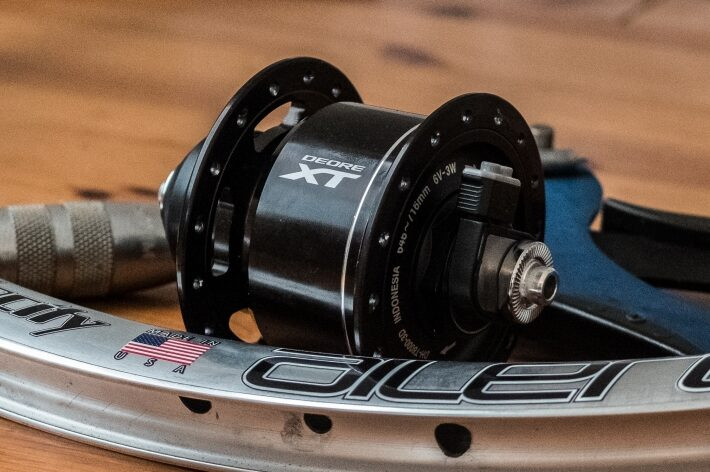 Everything you ever wanted to know about bike dynamos
Everything you ever wanted to know about bike dynamos
Pros: Very affordable, wide range of models, strong power output at low speeds.
Cons: Heavier than premium options, limited servicing options.
Shimano dynamo hubs are an excellent choice for cyclists seeking affordability and practicality. They offer a range of dynamo hubs from entry-level to Deore XT level, suitable for both rim and disc brake bikes. Shimano hubs are known for providing good power output even at lower speeds, making them well-suited for commuting and general cycling. While heavier than premium hubs like SON, Shimano dynamos are robust and reliable. Servicing options are somewhat limited, but basic maintenance of non-driveside bearings is possible, and the generator assembly can be replaced without wheel disassembly.
Velogical Sport Bottle Dynamo
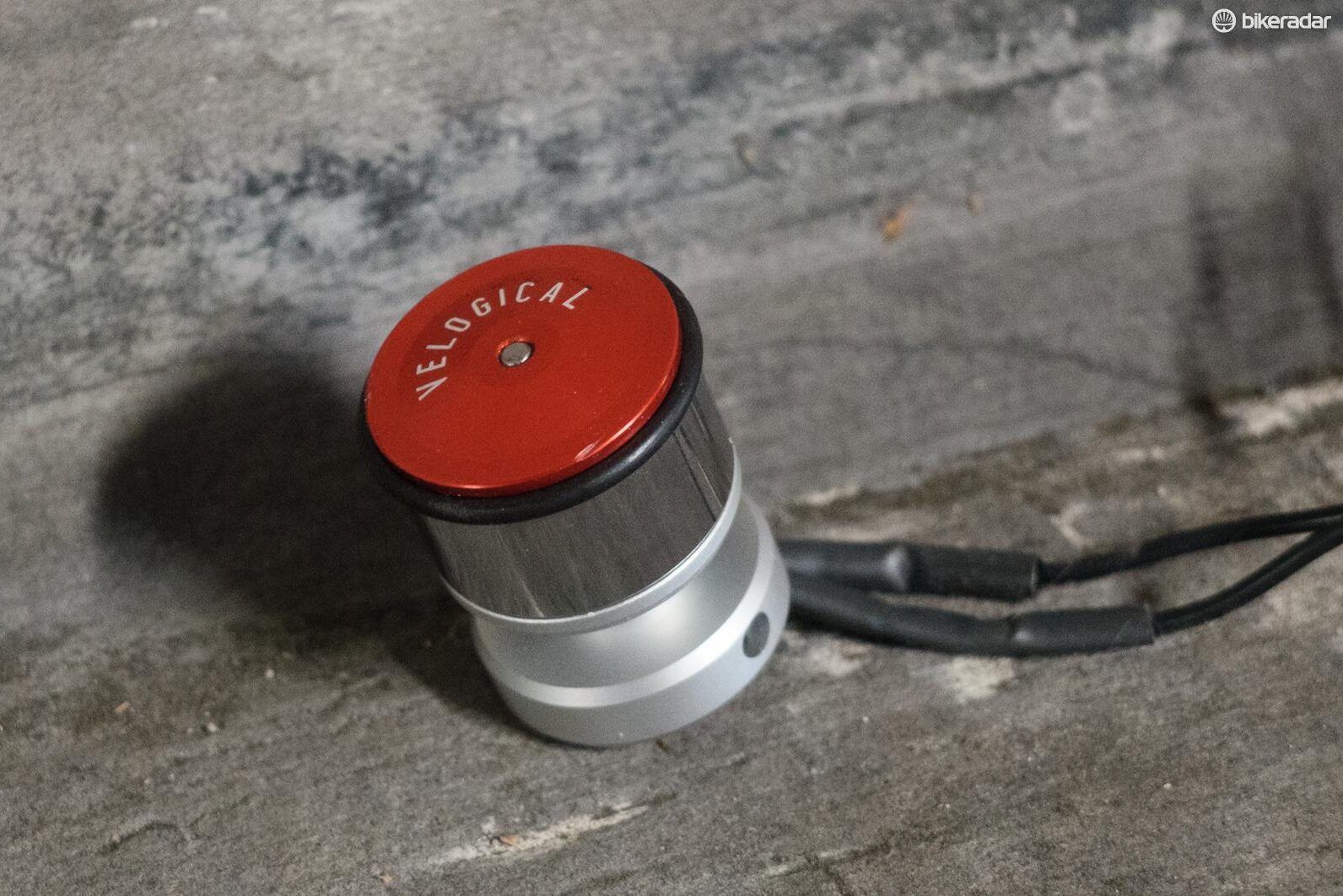 Everything you ever wanted to know about bike dynamos
Everything you ever wanted to know about bike dynamos
Pros: Adaptable to different bikes, lightweight.
Cons: Can be fiddly to set up initially, less sleek than hub dynamos.
The Velogical Sport bottle dynamo presents a unique and versatile option, particularly for cyclists who own multiple bikes or prefer not to rebuild wheels with dynamo hubs. Velogical dynamos are known for their lightweight and well-engineered design, representing a significant improvement over older bottle dynamo designs. A key advantage is the ability to easily disengage the dynamo when not needed, eliminating drag. Initial setup can be a bit more involved, but the design and construction quality are highly regarded.
Best Dynamo Lights
SON Edelux II
 Everything you ever wanted to know about bike dynamos
Everything you ever wanted to know about bike dynamos
Pros: Superb build quality, excellent beam optics.
Cons: Premium price.
SON Edelux II headlights are consistently praised as top-tier dynamo lights. Their build quality is unmatched, and they utilize advanced beam optics licensed from Busch + Müller, providing an ideal beam pattern for road and gravel riding. The Edelux II is available in various mounting configurations and colors, offering versatility and customization. While expensive, the performance and durability justify the investment for serious cyclists.
Busch + Müller IQ-X
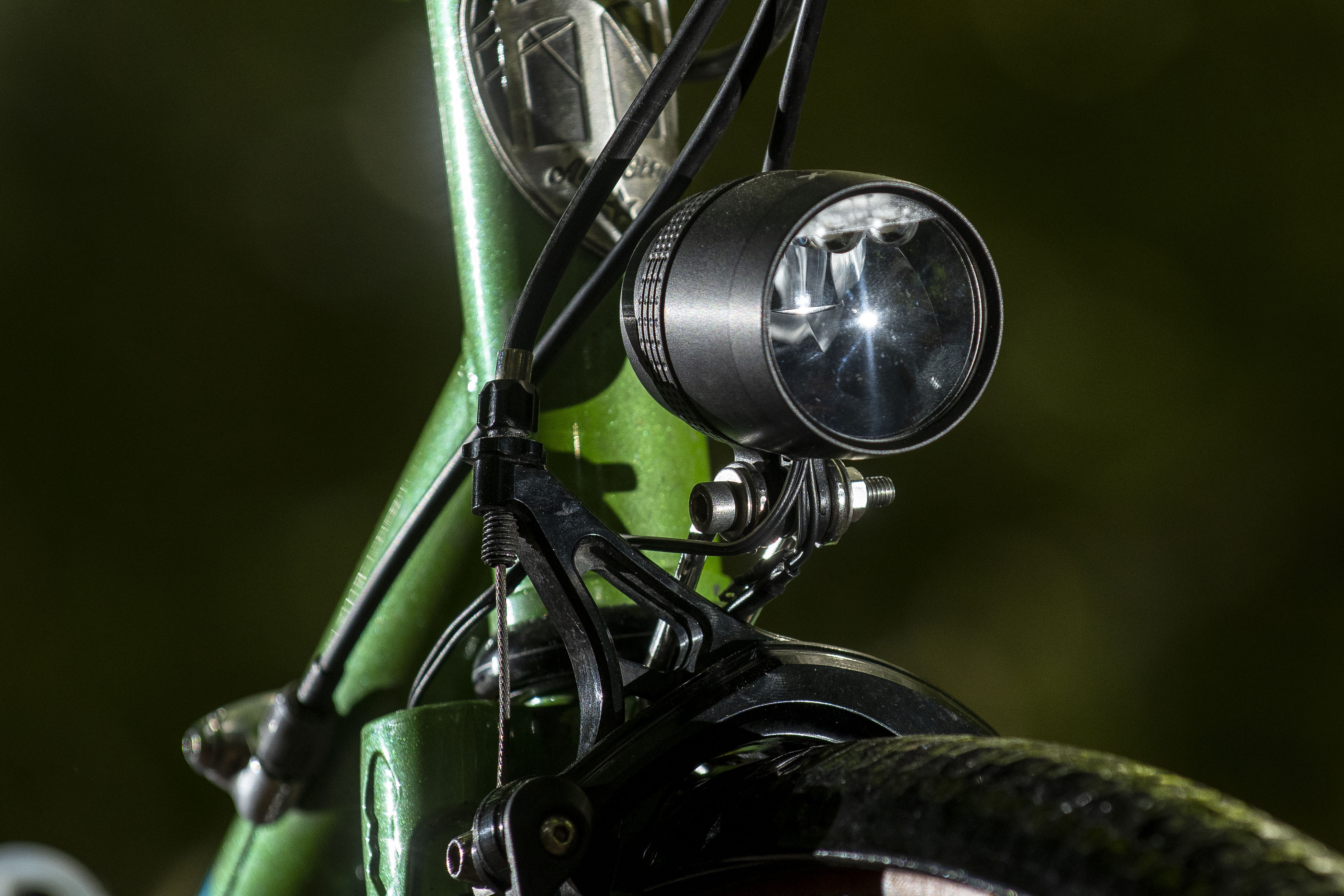 Everything you ever wanted to know about bike dynamos
Everything you ever wanted to know about bike dynamos
Pros: Performance comparable to SON at a lower cost.
Cons: Build quality less premium than SON, some susceptibility to water ingress.
The Busch + Müller IQ-X headlight offers performance close to the SON Edelux II but at a more affordable price. It utilizes similar beam optics but employs a housing with a mix of alloy and plastic components, resulting in a slightly less robust feel compared to the Edelux. However, in practical use, the IQ-X performs admirably. Some users have reported minor issues with water ingress, so care should be taken when washing or storing the bike upside down.
Exposure Revo
 The Exposure Revo and Hunt Superdura Disc Dynamo wheel are my favourite parts on the bike.
The Exposure Revo and Hunt Superdura Disc Dynamo wheel are my favourite parts on the bike.
Pros: Very powerful output, exceptional standlight duration.
Cons: No fork crown mounting option.
The Exposure Revo is a premium dynamo light particularly well-suited for off-road cycling and bikepacking. It delivers a powerful light output and features an outstanding standlight that can provide up to an hour of usable light, gradually dimming as it discharges, making it ideal for extended stops during bikepacking trips. The Revo uses convenient coaxial connectors and includes an output port for charging devices or connecting a rear light. It is compatible with Exposure’s accessory ecosystem, but lacks a dedicated fork crown mounting option, which may be preferred by some cyclists.

